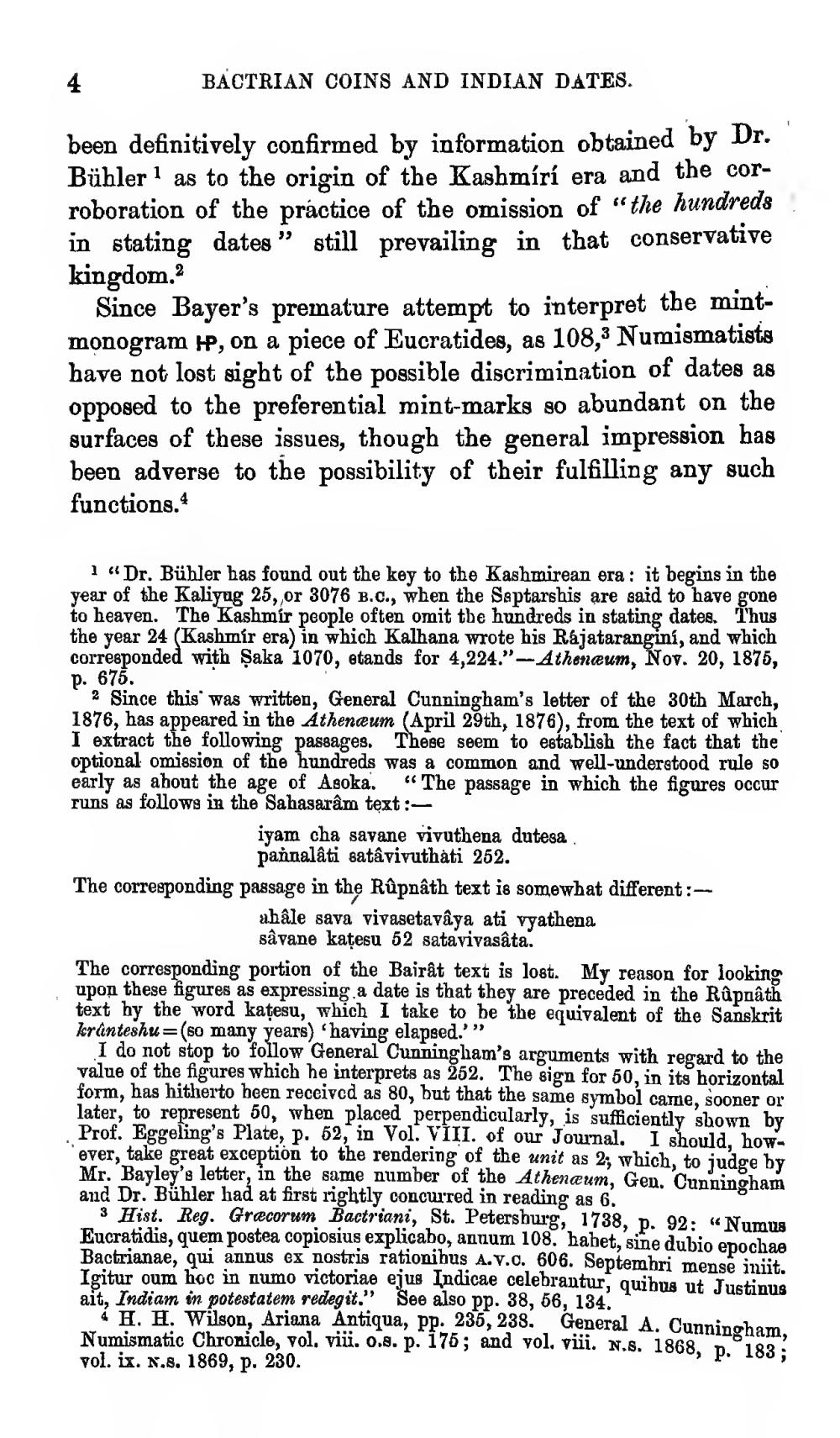________________
4
BACTRIAN COINS AND INDIAN DATES.
been definitively confirmed by information obtained by Dr. Bühler 1 as to the origin of the Kashmírí era and the corroboration of the practice of the omission of "the hundreds in stating dates” still prevailing in that conservative kingdom.
Since Bayer's premature attempt to interpret the mintmonogram HP, on a piece of Eucratides, as 108,3 Numismatists have not lost sight of the possible discrimination of dates as opposed to the preferential mint-marks so abundant on the surfaces of these issues, though the general impression has been adverse to the possibility of their fulfilling any such functions.
1 "Dr. Bühler has found out the key to the Kashmirean era: it begins in the year of the Kaliyug 25, or 3076 B.C., when the Saptarshis are said to have gone to heaven. The Kashmir people often omit tbe hundreds in stating dates. Thus the year 24 (Kashmir era) in which Kalhana wrote his Rájatarangini, and which corresponded with Şaka 1070, stands for 4,224."- Atheneum, Nov. 20, 1875, p. 675.
2 Since this was written, General Cunningham's letter of the 30th March, 1876, has appeared in the Atheneum (April 29th, 1876), from the text of which I extract the following passages. These seem to establish the fact that the optional omission of the hundreds was a common and well-understood rule so early as about the age of Asoka. “The passage in which the figures occur runs as follows in the Sahasarâm text:
iyam cha savane vivuthena dutesa
pannalâti satâvivuthati 252. The corresponding passage in the Rûpnâth text is somewhat different:
ahâle sava vivasetavậya ati vyathena
sâvane kațesu 52 satavivasata. The corresponding portion of the Bairât text is lost. My reason for looking upon these figures as expressing a date is that they are preceded in the Rûpnâth text hy the word katesu, which I take to be the equivalent of the Sanskrit krânteshu=(50 many years) 'having elapsed.'”
I do not stop to follow General Cunningham's arguments with regard to the value of the figures which he interprets as 252. The sign for 50, in its horizontal form, has hitherto been received as 80, but that the same symbol came, sooner or later, to represent 50, when placed perpendicularly, is sufficiently shown by Prof. Eggeling's Plate, p. 52, in Yol. VIII. of our Journal, I should how ever, take great exception to the rendering of the unit as 2; which, to judge by Mr. Bayley's letter, in the same number of the Athenæum, Gen. Cunningham and Dr. Bühler had at first rightly concurred in reading as 6.
3 Hist. Reg. Græcorum Bactriani, St. Petersburg, 1738, p. 92: “Numus Eucratidis, quem postea copiosius explicabo, annum 108. habet, sine dubio epochae Bactrianae, qui annus ex nostris rationibus A.Y.. 606. Septembri mense iniit. Igitur oum hoc in numo victoriae ejus Indicae celebrantur, quibus ut Justinus ait, Indiam in potestatem redegit." See also pp. 38, 56, 134
H. H. Wilson, Ariana Antiqua, pp. 235, 238. General A. Cunningham, Numismatic Chronicle, vol, viü. 0.8. p. 175; and vol, viii. N.s. 1868. D.1831 vol. ix. .8. 1869, p. 230.




